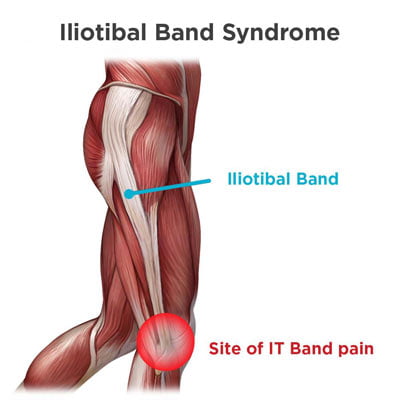If you’re a runner or cyclist, chances are you’re aware of the importance of strengthening all the muscles surrounding your knees. The knees play an integral part of your ability to perform. They’re such complex weight-bearing joints that it’s relatively easy to injure them. And a damaged knee causes you so much pain that you can’t engage in your favorite sport. Instead, whether you’ve developed iliotibial band syndrome or some other form of knee damage, call on the top-rated pain doctors at New York pain management for a thorough evaluation, a clear diagnosis and the latest in pain treatment options.
The iliotibial band is the long band of tissue that runs from your hip bone to the outside of your shin bone. Known as iliotibial band syndrome or runner’s knee, the condition occurs when this band of tissue becomes irritated or injured. It can cause pain, especially while exercising, running or cycling.
As one of the most common forms of knee pain, repetitive flexing and extending can cause the iliotibial band to become inflamed and irritated. The pain and discomfort sometimes may be great enough that is causes you to stop all exercise activities. Although the condition is easily diagnosed, iliotibial band syndrome treatment can be challenging, which is why you need to rely on the experience and expertise of the top-rated pain doctors at injury clinic NYC.
Symptoms and Causes of Iliotibial Band Syndrome
Iliotibial band syndrome most often appears as lateral knee pain with swelling, tightness and achiness along your outer leg and knee. The pain is often spread over a wide area. Sometimes, the inflammation causes referred hip pain. One theory proposes that weak hip abductor muscles may contribute to many cases of iliotibial band syndrome.
 Runners and cyclists seem to be most susceptible to iliotibial band syndrome. Not only is overuse a factor, but poor form and improper biomechanics also contribute to the condition. Stronger muscles may overcompensate for weaker muscles, pulling your stride or pedal motion in a way that stresses this band of tissue. As the band thickens with repetitive motion, the space also becomes filled with fluid that increases the swelling and discomfort.
Runners and cyclists seem to be most susceptible to iliotibial band syndrome. Not only is overuse a factor, but poor form and improper biomechanics also contribute to the condition. Stronger muscles may overcompensate for weaker muscles, pulling your stride or pedal motion in a way that stresses this band of tissue. As the band thickens with repetitive motion, the space also becomes filled with fluid that increases the swelling and discomfort.
Other indicators of a propensity for iliotibial band syndrome include:
- High weekly mileage, whether running or riding
- Pre-existing tightness across this band of tissue
- Certain types of interval training
- Walking or running on a track or other hard surface
- Standing and slightly flexing of the knee tends to aggravate your pain
- Weak knee flexors, hip abductors or knee extensors
Diagnosing Iliotibial Band Syndrome
The best knee pain doctors in Manhattan can diagnose iliotibial band syndrome fairly quickly. Show your doctor where you feel tenderness and discomfort. He may palpitate your outer knee area. During your physical examination, he may notice swelling along the band and find multiple trigger points of pain.
Your doctor may also check the strength of your knee flexors and hip abductors. Ober’s test requires you to lie on the floor on your unaffected side with your knee bent. Most individuals requiring iliotibial band syndrome treatment cannot comfortably lower the affected knee to the floor in this position. Occasionally, your doctor may also order an MRI to get a complete picture of your injury.
Iliotibial Band Syndrome Treatment
Treatment can be tricky for iliotibial band syndrome. Finding the proper balance between increasing the flexibility of this band of tissue and decreasing inflammation and tenderness requires the finesse and knowledge of a pain specialist. Some treatment options include:
- Therapeutic massage that relaxes and stretches the band of tissue
- Activity modification that ceases all repetitive motion to give the tissue time to heal
- Physical therapy that includes multiple specialized stretching and strengthening exercises to encourage strong hip abductors that keep the iliotibial band long and flexible
- Nerve block injections that reduce the pain enough so that you can participate fully in physical therapy
- Anti-inflammatory and pain-relieving medications
- Ice or cold packs to reduce inflammation
- Corticosteroid injections if your pain persists for longer than a few days
You should only resume running and cycling after all the strength exercises you’ve been given can be performed without significant discomfort. Follow your pain doctor’s instructions, start at a slow, even pace on level ground. Build up slowly, giving your hips, knees and damaged iliotibial band time to acclimate and get stronger.
Additional Iliotibial Band Syndrome Treatment
In rare cases, when all other treatments have been ineffective, your best pain management specialists in Manhattan may recommend minimally invasive surgery to release part of the tightened band that runs across your femur. Research suggests that up to 84 percent of individuals who must undergo this surgery report good to excellent results.
Though iliotibial band syndrome treatment can be tricky, finding the most accurate diagnosis and treatment options remains the focus of your injury doctor. Through interventional treatments, the goal is to minimize the friction of the band of tissue over your femur and other structures, allowing you to gather speed and distance during your exercise routines.
Don’t hesitate to get medical help for a sore knee, because whatever your condition is now, it can get worse. Contact Pain Management NYC for a treatment plan that gets you back to your active routines.

Leon Reyfman, MD, is a top-rated, best-in-class interventional pain management doctor. He is a nationally recognized pain relief specialist and is among the top pain care doctors in New York City and the country. He is an award-winning expert and contributor to prominent media outlets.
Dr. Leon Reyfman has been recognized for his thoughtful, thorough, modern approach to treating chronic pain. He has been named a “top pain management doctor in New York” and one of “America’s Top Doctors™” for advanced sports injury treatments. Among other accolades, he was voted by peers as a “Castle Connolly Top Doctors™” and “New York Super Doctors™”. Dr. Leon Reyfman was a part of the medical team at the 2016 Summer Olympic Games in Rio de Janeiro, Brazil.
